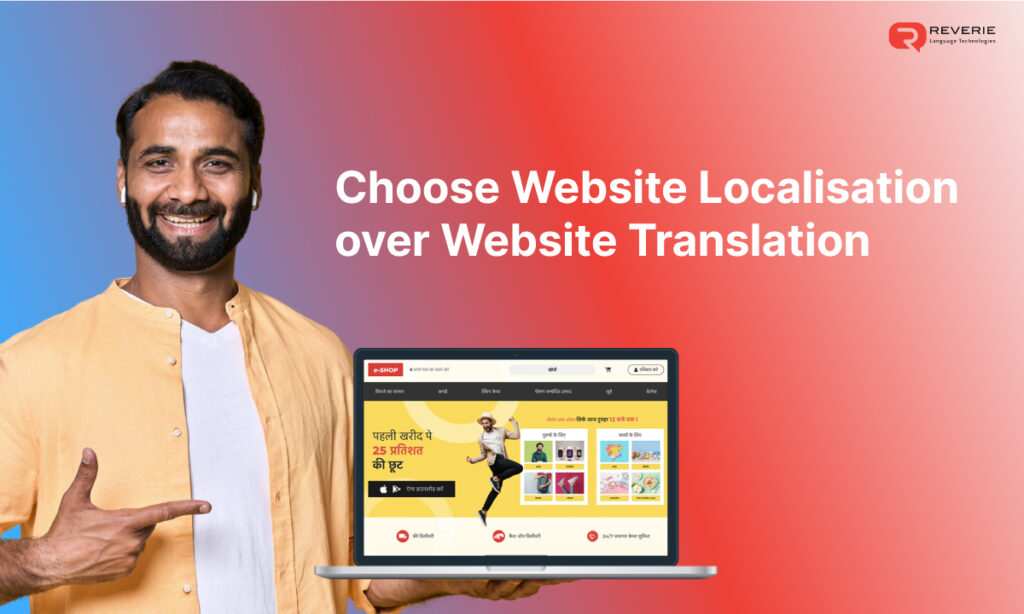Catering to diversified audiences requires breaking linguistic and cultural barriers. A business website, the first touchpoint with prospects, should transcend these limits, reflecting the users’ cultural nuances, tastes, and backgrounds to nurture genuine relationships.
The two preferred ways to achieve this goal – website localisation and website translation determine a brand’s impact and resonance. While website translation predominantly focuses on converting content from one language to another, website localisation dives deeper. It’s about adapting and customizing the entire user experience, making it more culturally and contextually relevant to the target audience.
In this blog, we’ll explore why businesses seeking diversified engagement should prioritize website localisation over website translation.
What is website localisation?
When Amazon entered the Indian market, they didn’t just translate their eCommerce website into Hindi or other regional languages. They tailored product assortment for Indian festivals (such as ‘The Great Indian Diwali Sale’), introduced popular payment methods like Cash on Delivery and UPI, offered multiple regional language support, and much more. This personal touch perfectly captures the essence of website localisation.
It’s the process of adapting and customizing a website not just linguistically but also culturally and functionally to cater to a target audience’s specific preferences, norms, and expectations in a particular region or country.
What is website translation?
Website translation converts a website’s textual content from one language into another. It’s primarily concerned with ensuring that the language used on the site is understandable to target language speakers.
For instance, PhonePay is an Indian digital payment and financial services company. Their app supports services in different Indian regional languages. If you are using the app in English and initiate a payment of ₹50, the app will pop the message ‘Rs 50 money received instantly on PhonePay’. However, if you switch to Hindi this message will be translated in ‘फोन-पे पर ₹50 का भुगतान तुरंत प्राप्त हुआ’
Website localisation vs. website translation: What’s the difference?
The differences between website localisation and translation are subtle but unique. Here are a few of them:
| Aspect | Website localisation | Website translation |
| Scope | Broad: encompasses language, design, content, functionality, and cultural elements. | Narrow: primarily focuses on language. |
| Cultural considerations | High priority: addresses cultural nuances, customs, symbols, and local expectations. | Low priority: concentrates on language accuracy, might overlook cultural nuances. |
| Technical adjustments | Includes changes to site functionality, such as currency conversion, date formats, and payment methods tailored to the locale. | Doesn’t involve functionality changes. |
| Time and cost | More time-consuming and expensive due to the comprehensive changes involved. | Faster and potentially less costly as it focuses mainly on linguistic changes. |
| User engagement | Improved user experience by aligning content with the audience’s cultural and functional expectations. | Provides basic accessibility in the native language, but may not optimize the user experience culturally. |
| Conversion potential | Higher: Appia research indicates that 86% of localized campaigns surpassed the English ones in terms of click-throughs and conversions. | Moderate: Accessibility in native language can improve conversion, but lacking cultural nuances might limit potential. |
| Goal | To create a site experience that feels native to the target audience in every aspect. | To ensure the website’s content is understandable to speakers of another language. |
| Importance for brands | Essential for brands aiming for deep market penetration and creating a holistic, culturally resonant user experience in different regions. | Crucial for initial accessibility in new markets where the primary language differs from the original website’s language. |
Why is website localisation a better choice than website translation?
Your website is the digital storefront of your business, representing your brand’s identity to your audience. It’s imperative that each word and phrase you put there reflects the quality and intent of your original message and preserves the integrity of your business message.
Relying on machine translation might be tempting due to its accessibility and speed. But, it needs the suggestions and settings that human translators bring. Website localisation services serve the best of two worlds, coupling the wise touch of humans with machine intelligence. Let’s examine a few use cases that highlight the advantages of this healthy relationship.
- Avoiding mistranslation and misinterpretation
Direct translations involve converting content word-for-word from one language to another. While this might seem efficient, it can lead to significant mistakes. For instance, a phrase that’s perfectly innocent in one culture might be offensive or nonsensical in another. Consider using the thumbs-up gesture as a friendly sign in Greece or Iran. What you perceive as a positive gesture might be considered impolite or even offensive to them.
Localisation takes a broader approach. By considering context, idiomatic expressions, and regional sensitivities, it ensures your message is clear and doesn’t hurt the audience’s emotions, minimizing the risk of unintended cultural gaffes.
- Building trust
When users visit a website and find content in their native language, tailored to their cultural nuances and context, they instantly feel a connection. This tailored content indicates that the brand values, understands, and respects their culture and preferences. Such actions decrease skepticism and enhance credibility.
For instance, imagine browsing an online store, and every product description, review, and even payment gateway instruction is in a foreign language. You’d likely hesitate to purchase due to concerns about misunderstanding the terms, product details, or return policies.
However, if that same website is localized—translated accurately and adapted culturally—you’d feel more at ease. You’d trust the brand more because they’ve made an effort to communicate in your language and respect your cultural norms.
- SEO & SEM benefits
Search Engine Optimization (SEO) and Search Engine Marketing (SEM) are powerful tools to increase a website’s visibility and traffic. By adapting content with region-specific keywords, sites rank higher on local search engines. This localized content attracts the right traffic, enhancing engagement and reducing bounce rates. It also boosts the efficacy of geo-targeted SEM campaigns (as mentioned earlier). This ensures digital visibility and optimal engagement.
4. Expanding market reach
Some website owners think simply adding languages makes them diversified. However, just translating isn’t enough. Each market has its own preferences. Recognizing these cultural differences helps connect better with locals. Moreover, it gives you an edge over competitors that haven’t yet expanded into those markets or have done so without proper localisation efforts.
Reverie’s website localisation solution builds genuine connections
Reverie’s Anuvadak cultivates an environment of trust and credibility. It’s your ticket to diversified markets with a local touch. Beyond swift website localisation, it also manages content, underpinning it all with crucial multilingual SEO optimization.
But there’s more to it. With a more efficient turnaround, Anuvadak cuts your localisation expenses by 60%, giving you a faster, cost-effective entry into the diversified market.



